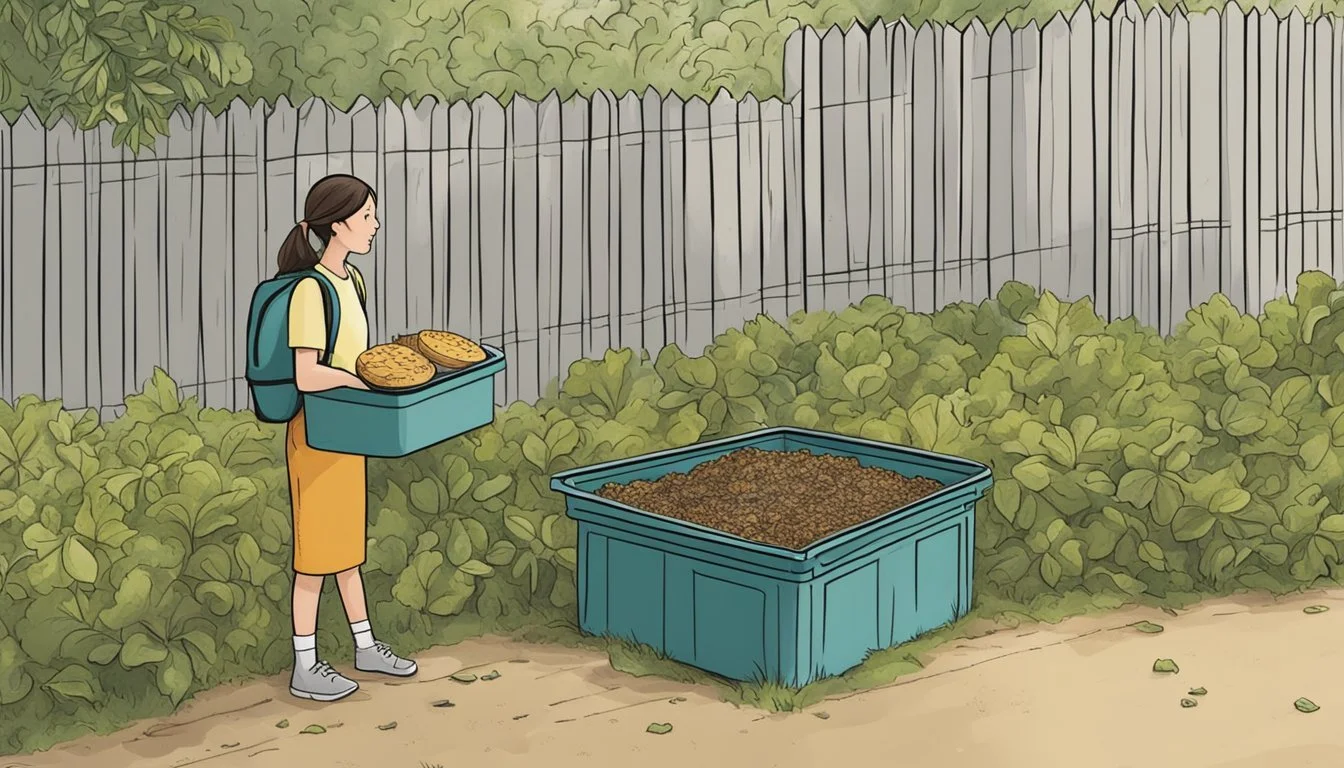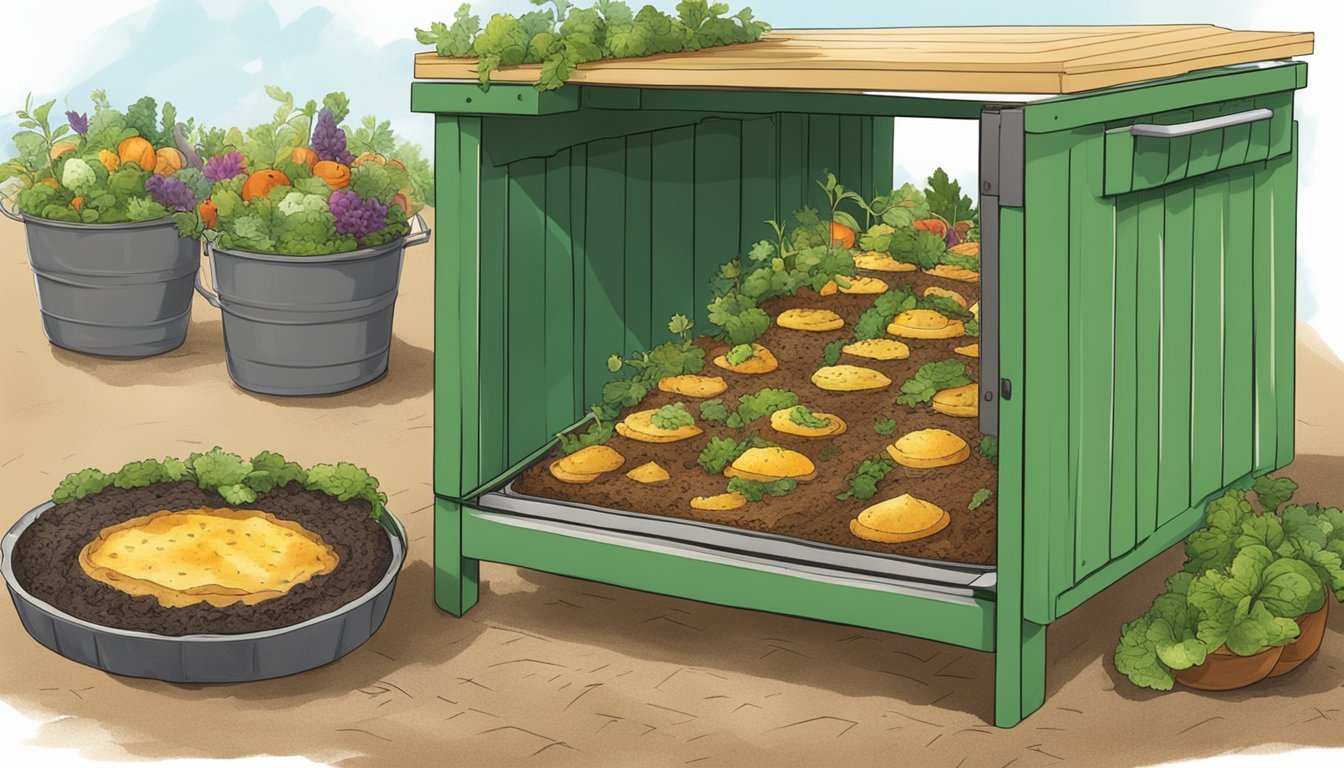Can You Compost Quiche?
Unpacking the Do's and Don'ts
When exploring environmentally friendly practices like composting, many enthusiasts often wonder about the diversity of kitchen scraps that can be added to their compost piles. Quiche, (What wine goes well with quiche?) a savory dish consisting of a pastry crust filled with eggs, milk, cheese, and often various other ingredients, might not be something commonly discussed in composting circles, yet it presents an interesting case. While the natural inclination is to minimize waste, it's important to recognize that not all food waste is suitable for composting.
Ingredient composition and potential food contamination are crucial considerations when adding items to a compost pile. Composting primarily relies on the ability of organic matter to break down naturally and safely, contributing to nutrient-rich soil. A general rule for successful composting is to avoid introducing dairy products, meats, and oils, which can attract pests, generate foul odors, and potentially disrupt the delicate balance of a composting system. Therefore, with its typical ingredients, quiche could be problematic if added directly to compost.
However, certain parts of the dish may still be compostable under the right circumstances. When quiche is deconstructed, components like the vegetable fillings, such as broccoli and zucchini, can be perfectly acceptable for compost piles. Care must be exercised to separate compostable from non-compostable elements, ensuring the process remains efficient and beneficial.
Essentials of Composting
The success of composting is rooted in understanding its process and maintaining the right balance of ingredients within your compost pile. This ensures efficient decomposition and the creation of nutrient-rich soil.
Understanding the Composting Process
Composting is a natural process where microorganisms break down organic matter into simpler substances. The decomposition is carried out by bacteria, fungi, and other organisms. Microorganisms require oxygen to thrive, making aeration an essential factor in the composting process. The right temperature and moisture level are also critical, as they accelerate the decomposition process. A well-maintained compost will transform organic waste into nutrient-rich soil, which can be used to improve garden health.
Components of a Healthy Compost Pile
A healthy compost pile requires a stable balance of carbon and nitrogen. These are often referred to as brown materials and green materials, respectively.
Brown Materials: High in carbon, these include dry leaves, straw, paper, and wood chips. They provide energy for microorganisms.
Green Materials: High in nitrogen, such as vegetable scraps, fruit waste, coffee grounds, and grass clippings. They help microorganisms reproduce and build cell structure.
The pile should maintain a carbon to nitrogen ratio of about 30:1. The mixture must be kept moist, akin to the wetness of a wrung-out sponge, to support the decomposition process. Moreover, ensuring effective air circulation within the compost bin or pile is essential. This can be done by turning the pile regularly or using a structure that promotes airflow. Keep in mind that improper balance of these elements can slow down the process, causing odors or incomplete decomposition.
What Can Be Composted
Composting is a method to recycle organic material. The proper balance of compostable items can create a nutrient-rich soil amendment beneficial for gardens.
Do's of Composting
Kitchen Scraps: Almost all vegetable and fruit waste, including peels, rinds, and cores, can be composted. Coffee grounds and eggshells are also ideal as they provide vital nutrients.
Yard Waste: Composting is great for disposing of leaves, straw, and grass clippings. They add necessary carbon and nitrogen to the compost pile.
Paper Goods: Non-coated cardboard and paper contribute to the brown materials needed for a balanced compost.
Don'ts of Composting
Animal Products: Items such as meat, fat, bones, and seafood should be avoided as they can attract rodents and cause odors.
Dairy and Fats: Cheese, grease, and other dairy products do not decompose well and can also lead to odor and disease problems in the pile.
Diseased Plants: Plants that are diseased should not be included as they may spread pathogens through the compost.
Special Considerations for Compostable Foods
Certain foods, like onions and eggs, while compostable, should be limited since they can sometimes impede the compost process or attract pests.
Ratio Balance: It's essential to maintain a good balance between greens (nitrogen-rich materials) and browns (carbon-rich materials) for optimal composting.
Quiche and Composting
Quiche, a dish that combines ingredients like eggs, cheese, and vegetables in a pie crust, presents unique considerations when it comes to composting.
Breaking Down Quiche Ingredients
To assess the compostability of quiche, one must consider the individual components:
Eggs: Rich in nitrogen, eggs are compostable, but they should be well mixed or crushed to aid in decomposition.
Cheese and Milk: Dairy products attract pests and can create foul odors; hence, they are typically not recommended for composting.
Pie Crust: Comprised of flour and fats, it can be composted if fats are minimal; otherwise, fats can hinder breakdown and attract rodents.
Vegetables: Most vegetable elements of a quiche, such as onions and zucchini, compost well, contributing to the nutrient content.
Meats: Ham or other meats pose similar problems to dairy and should generally be excluded from compost to avoid pests.
Herbs: Herbs from quiche add beneficial compounds and can improve compost aroma.
Potential Issues with Composting Quiche
Several problems can arise when composting quiche:
Dairy and Meat Fats: The fats and grease in quiche can slow decomposition, attract unwanted pests, and potentially unbalance the compost's nutrient mix.
Salt Content: High salt levels can harm beneficial compost microbes.
Foul Odors: Dairy and meat in quiche can decompose anaerobically, producing unpleasant smells.
Attraction of Rodents: Fats, dairy, and meats within quiche are more likely to attract rodents to the compost pile.
Best Practices for Composting Quiche
When adding quiche to a compost pile, it's critical to balance it with appropriate materials and to maintain the pile properly to ensure efficient decomposition.
Proper Ratios in Composting
The success of composting quiche, an organic material rich in nitrogen, depends on balancing it with brown materials high in carbon. Adhering to the recommended ratio of 1 part green materials (including food waste like quiche) to 3 parts brown materials (such as twigs, paper, and cardboard) is vital. This ratio ensures an optimal environment for microorganisms to break down the food effectively.
Green Materials: Quiche, vegetable scraps, coffee grounds
Brown Materials: Dry leaves, branches, paper, cardboard
Mixing these materials regularly helps maintain an even distribution of air and moisture levels throughout the compost. Regular turning of the pile is crucial to expose all parts of the compost to high temperatures, which are necessary for a thorough decomposition process.
Maintaining Your Compost Pile
A well-maintained compost pile should have a balance of water and air. The compost should be moist, like a wrung-out sponge, but not waterlogged. Monitoring the moisture levels and adding water if it seems too dry or adjusting with more brown materials if too wet is key.
Temperature is another essential factor; the pile should feel warm to the touch. This warmth indicates microbial activity. By turning the pile, one can inject fresh air and redistribute heat and moisture, keeping the compost healthy and active.
Avoiding and Addressing Problems
Proper composting of quiche requires meticulous attention to potential issues such as invasive pests and unpleasant odors, as well as ensuring optimal conditions for decomposition. By meticulously managing these aspects, one can maintain an efficient composting process.
Invasive Pests and Odor Control
When composting food items like quiche, invasive pests such as rodents and insects can be attracted to the compost pile. To deter these pests, it's essential to:
Cover food scraps — with a layer of browns such as leaves or straw.
Maintain proper compost balance — a healthy mix of greens and browns reduces odor and pest attraction.
Secure the compost bin — a bin with a locking lid or secure fencing discourages rodents.
Foul odors often indicate an imbalance within the compost. Mitigating foul odor involves:
Enhanced air circulation — turning the compost regularly to introduce oxygen, which is vital for aerobic microorganisms to thrive.
Monitoring moisture — compost should be moist, but not soggy. Adjusting water levels prevents the anaerobic conditions that cause bad smells.
Maximizing Decomposition Efficiency
The efficiency of the decomposition process within a compost pile directly influences its success. Here's how to ensure that quiche and other biodegradables decompose effectively:
Optimal temperature — the compost pile should maintain a temperature between 135°F and 160°F to encourage microorganism activity while killing pathogens and weed seeds.
Regular mixing — this aids in evenly distributing microorganisms, moisture, and heat throughout the pile, which accelerates the decomposition process.
Proper size — a compost pile should be at least 3 feet high and wide to maintain the necessary heat, but not so large that it restricts air flow.
By addressing these specific aspects, one can prevent problems and maintain an eco-friendly, efficient composting system.
Using Finished Compost
Once compost has fully decomposed, it transforms into a nutrient-rich substance beneficial for enhancing the growth and health of plants. Finished compost acts as a natural fertilizer, contributing both nutrients and organic matter to the soil.
Applying Compost to Gardens
Gardens thrive when they receive ample nutrients and organic matter from finished compost. To apply:
Vegetable and Flower Beds: Spread a 2-4 inch layer of compost over the soil and work it into the top 6 inches of soil before planting.
Trees and Shrubs: Apply a 1-3 inch layer around the base, extending to the drip line, and gently work it into the soil.
Frequency: Annually or as needed to maintain soil fertility.
Compost as a Resource for Sustainable Living
Compost enriches soil, promoting sustainable living through:
Soil Structure Improvement: It increases the soil's ability to retain moisture and resistance to compaction.
Waste Reduction: Diverts organic household waste from landfills, reducing methane emissions.
Additional Benefits:
Encouraging the presence of beneficial microorganisms.
Decreasing the need for chemical fertilizers, thus protecting the environment.
Related Topics
Exploring the intersection of food waste, such as quiche, and sustainable practices like composting provides a multifaceted approach to waste reduction and environmental stewardship. This section dives into specific quiche recipes suitable for composting, the environmental impact of composting food waste including quiches, and advanced techniques to improve the composting process.
Quiche Recipes for Composting
When considering quiche recipes for composting, it's important to select ingredients that are compostable. A typical quiche contains eggs, milk, cheese, and vegetables—all of which can be composted. However, one should avoid adding components like dairy products in large amounts as they can create odor problems and attract pests. Here's a basic recipe suitable for composting purposes:
Quiche Lorraine: Incorporate compostable ingredients such as eggs, cheese, and small amounts of cooked bacon. Avoid a large dairy content and opt for a compostable crust.
Crustless Quiche: Ideal for composting, this recipe excludes the pie crust, focusing on eggs, vegetables, and modest amounts of cheese.
Environmental Benefits of Composting
Composting quiche and other food scraps turns organic material into nutrient-rich soil, contributing to sustainable living practices. Here's a snapshot of the benefits:
Reduction in landfill use: Composting food waste like quiche reduces the volume of waste sent to landfills.
Decrease in greenhouse gas emissions: By avoiding anaerobic decomposition in landfills, composting quiche curtails methane production.
Advanced Composting Techniques
For effective quiche composting, one should balance carbon (browns) and nitrogen (greens). Use the following ratio for optimal decomposition:
Browns: Add materials such as shredded wood chips, twigs, leaves, hay, or sawdust.
Greens: Insert quiche scraps, grass clippings, and fresh plant matter.
Ensuring adequate water, air, and high temperatures facilitates the transformation into compost.
Employing shredding methods to break down larger pieces of waste, including quiche, accelerates the composting process and produces high-quality compost quicker.









